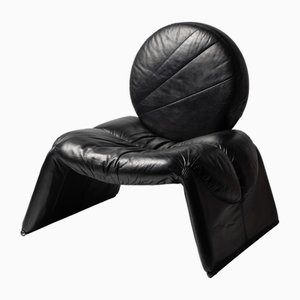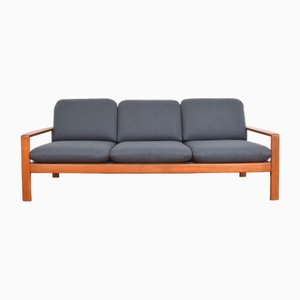Swedish mega-brand Ikea was founded by Småland-born Ingvar Kamprad (1926) in 1943. According to legend, Kamprad even as a boy had big dreams of starting his own business, and he was able to launch Ikea at age 17 through a small loan from his father as a reward for doing well in school. The name is an acronym for “Ingvar Kamprad Elmtaryd Agunnaryd”—Elmataryd being the name of the farm where Kamprad grew up, and Agunnaryd the name of his hometown. The company’s philosophy from the beginning was grounded in a Swedish socialist tenant: “people who are not well off should be given the same opportunities as people who are.”
In the early years, Ikea did not sell the furniture for which it is now famous; instead, it sold a variety of household items, like soap, pens, and stockings, at first locally and then by mail order through print advertisements. Ikea launched its first furniture line in 1948 with a few armchairs and tables produced by artisans in the Småland region. The first annual Ikea catalogue was issued in 1951.
When Ikea began retailing furniture at factory prices by mail order in the early 1950s, the established furniture trade saw this move as disruptive to their business. Ikea was not permitted to exhibit in the major furniture fair in Stockholm for decades, and suppliers were encouraged to cease working with Ikea. Kamprad was not deterred. In the mid-to-late-1950s, he commissioned Gillis Lundgren—an Ikea employee—along with Danish designers Bengt Ruda and Erik Wørts, to create new Ikea furniture lines grounded in the modernist concepts of affordability, modularity, interchangeable parts, flat-packing, and self-assembly. The first Ikea showroom opened in Älmhult in 1958. The Tore Drawers (1958), Regal Bookshelf (1959), and Thonet-like Ölga Chair (1961) were among of the company’s first successes in modern furniture design.
Ikea’s program for inexpensive, mass produced furnishings was greatly facilitated by the development of new materials in the 1960s, especially particleboard and plastics. When problems with Swedish suppliers came to a head, Ikea moved production to Denmark and Poland. Still, sales volumes steadily grew, and Ikea opened more showrooms. In 1963, Ikea opened its first store outside of Sweden, in Norway, followed in 1969 by a location in Denmark. In the 1970s, Ikea expanded to Switzerland, Germany, Australia, Canada, Austria, and the Netherlands. Also in the 1970s, Ikea was one of the first furniture companies to introduce self-service storage shopping for customers and computer systems for distribution management. In 1986, Ingvar Kamprad retired from executive management, and Ikea was divided into three separate entities: Inter Ikea Group, Ingka Group, and Ikano Group. In 1998, Ikea opened its first store in China.
Over the decades, Ikea has worked with myriad designers, both inside and outside Sweden. Iconic designs produced by Ikea include the wooden MTP Shelving System (1963) by Marian Grabinski; the space age Telegono Lamp (1970) by Vico Magistretti (originally designed for Artemide); the convertible Tajt Chair (1973) by Gillis Lundgren; the molded plastic Skopa Chair (1974) by Olle Gjerlöv-Knudsen and Torben Lind; the bentwood Poäng Chair & Ottoman (1977) by Noboru Nakamura; the enduring Billy Shelving System (1978) by Gillis Lundgren; the pop, plastic Mammut Child’s Chair & Table (1993) by Morten Kjelstrup and Allan Østgaard; the vibrant and tectonic Vilbert Chair (1993) in MDF by Verner Panton; and the biomorphic, rattan Storvik Lounge Chair (2002) by Carl Öjerstam. Notably, Ikea developed a number of highly successful designs with Danish design Niels Gammelgaard, like the Folke Chair (1977), Ted Net Chair (1978), Järpen Chair (1980), Moment Sofa (1983), Moment Table (1985), Guide Shelf (1985), Oti Chair (1986), Natura Storage (1990), and Trofast Toy Storage (1994).
Today, Ikea has more than 300 showrooms in nearly 30 countries and has built an incomparable international identity. Yearly worldwide sales have reached over 28 billion. The various Ikea companies and foundations are overseen by Ingka Holding B.V., and Ingvar Kamprad is senior advisor to the board. The designs produced by the company remain dedicated to “simplicity is a virtue,” while increasingly exploring the possibility of eco-friendly mass production methods.
























Get in Touch
Make An Offer
We noticed you are new to Pamono!
Please accept the Terms & Conditions and Privacy Policy
Get in Touch
Make An Offer
Almost There!
To follow your conversation on the platform, please complete the registration. To proceed with your offer on the platform, please complete the registration.Successful
Thanks for your inquiry, someone from our team will be in touch shortly
If you are a Design Professional, please apply here to get the benefits of the Pamono Trade Program